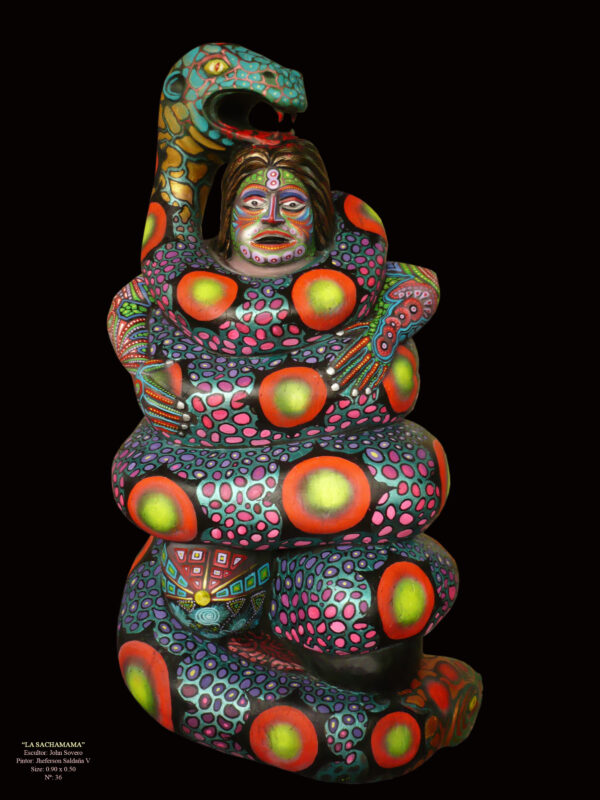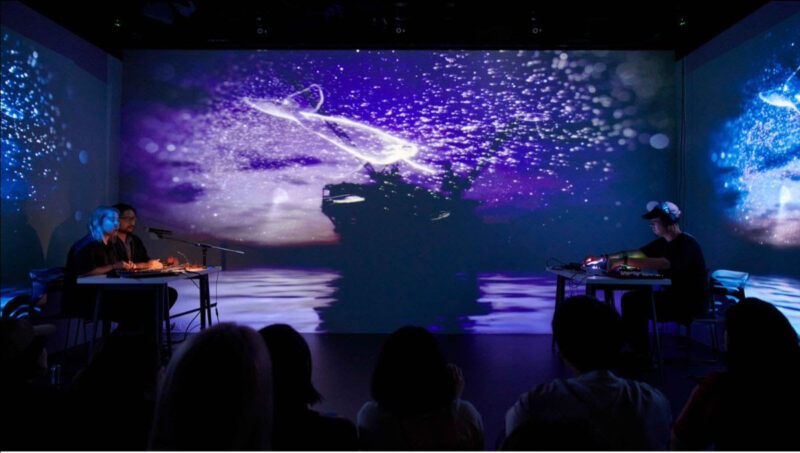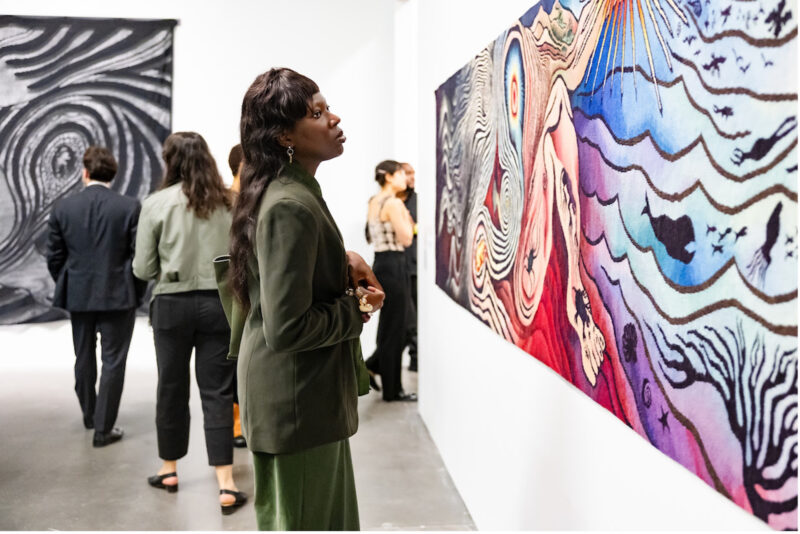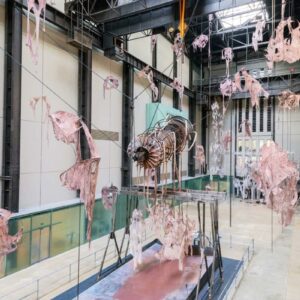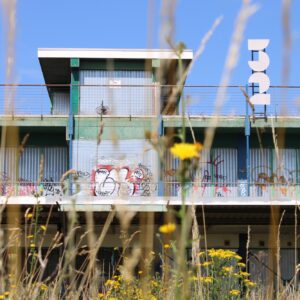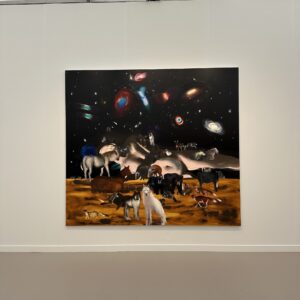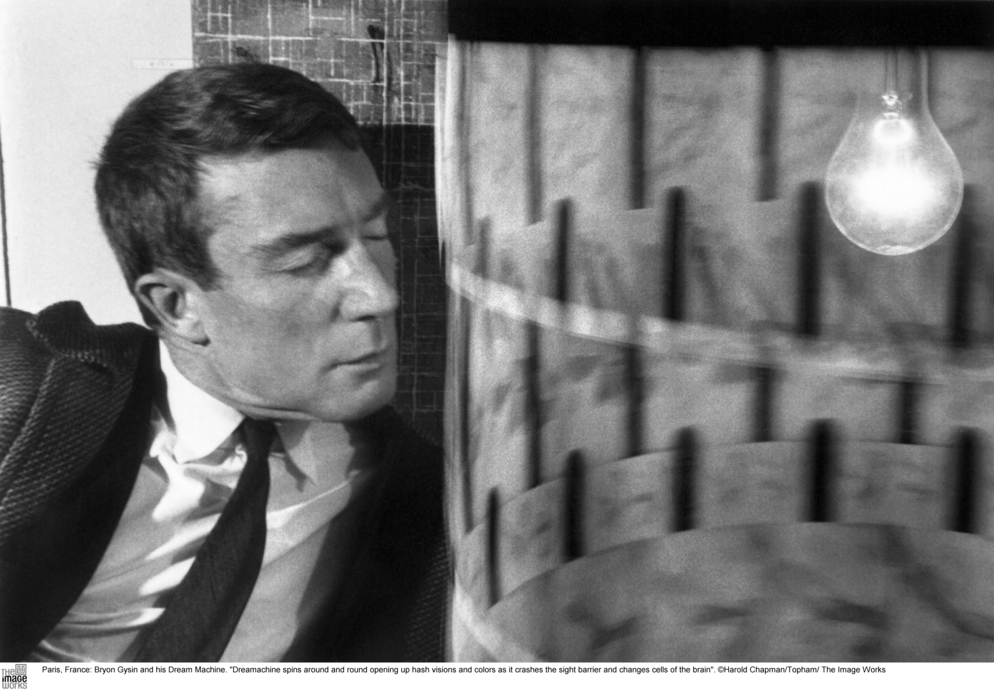
Image:gysinwithdreamachine Brion Gysin with Dreamachine at Musée des Arts Décoratifs, Paris, 1962. Collection William S. Burroughs Archive, Courtesy William S. Burroughs Trust, Lawrence, Kansas. Photo: Harold Chapman/Image Works
The New Museum will present “Brion Gysin: Dream Machine,” the first US retrospective of the work of the painter, performer, poet, and writer Brion Gysin (born 1916, Taplow, UK – died 1986, Paris). Working simultaneously in a variety of mediums, Gysin was an irrepressible inventor, serial collaborator, and subversive spirit whose considerable innovations continue to influence musicians and writers, as well as visual and new media artists today. The exhibition will include over 300 drawings, books, paintings, photo-collages, films, slide projections, and sound works, as well as an original Dreamachine–a kinetic light sculpture that utilizes the flicker effect to induce visions when experienced with closed eyes. “Brion Gysin: Dream Machine” is curated by Laura Hoptman, Kraus Family Senior Curator, and will be on view in the New Museum’s second floor gallery from July 7 through October 3, 2010.

Image:gysin_untitled1960 Brion Gysin, Untitled, 1960. Oil and ink on paper, 21 5/8 x 17 1/8 in (55 x 43.5 cm). Collection Shane Akeroyd
“An exhibition of an artist who died more than twenty years ago represents an approach to the notion of the new that is somewhat different from the Museum’s standard—one that emphasizes relevance and fresh information over chronology, and brings to the fore a relatively neglected yet very influential innovator who continues to have a strong impact on artists working today,” said Laura Hoptman.
In 1959, Gysin created the Cut-Up Method, in which words and phrases were literally cut up into pieces and then rearranged to untether them from their received meanings and reveal new ones. His Cut-Up experiments, which he shared with his lifelong friend and collaborator William S. Burroughs, culminated in Burroughs and Gysin’s The Third Mind, a book-length collage manifesto on the Cut-Up Method and its uses. Transferring this notion to experimenting with tape-recorded poems manipulated by a computer algorithm, Gysin created sound poetry and was among the earliest users of the computer in art. At the same creative moment, Gysin conceived of the Dreamachine. During the ’60s, ’70s, and ’80s, Gysin would continue his collaborations, and prove to be a mentor for myriad artists, poets, and musicians, from John Giorno to Brian Jones, to David Bowie and Patti Smith, to Genesis Breyer P-Orridge and Keith Haring, among many others.
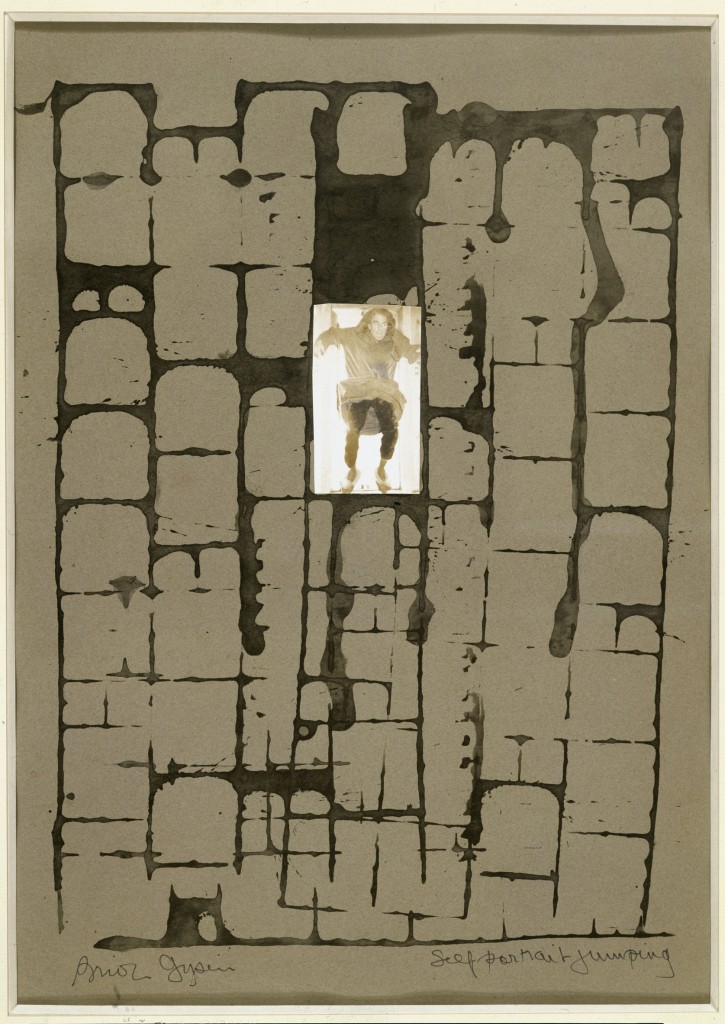
Image:gysin_selfportraitjumping1974 Brion Gysin, Self-Portrait Jumping, 1974. Gouache and photo-collage on colored paper, 14 5/8 x 10 3/8 (37 x 26.5 cm). Musée d’Art Moderne de la Ville de Paris
The Cut-Up Emerges from Paintings and Drawings
Gysin’s painting style manifested itself in a series of calligraphic paintings and drawings that he began to produce in Morocco from the late 1950s to the early 1960s. These were an attempt to fuse writing and painting into a single complex system of mark-making. A linguist who was knowledgeable in written Japanese as well as Arabic, Gysin’s script-like marks show the influence of both styles of calligraphy. Basing many of his compositions on the grid formation of written magic spells, Gysin’s mark-making runs from top to bottom as well as right to left, creating a dense pattern of incantatory language. (Watch Gysin make paintings here.) At the same time Gysin was working with painting as a form of writing; he devised a method of using words as a painter uses paint. Using found text, sound, and pictures, Gysin cut up and rearranged preexisting pieces of information. He also collaborated with Ian Sommerville, a mathematician and budding computer scientist studying at Oxford University, around 1960 to computerize the process of permutating words and sounds, naming his experiments with printed words and magnetic tape Permutations. Works like “Pistol Poem” (1960), which is comprised solely of pistol shots recorded at varying distances, and the poem “I Am That I Am” (1961) made him a pioneer of sound poetry. Embracing magnetic tape and computer technology, at a time when only scientists–and not artists–were working with it, Gysin equated his Permutations with that of a machine. Often performing these works accompanied by music and handmade slide projections, Gysin also was an early practitioner of multimedia performance. Gysin’s performances, done intermittently in Europe from 1960 through 1965, were never documented by film or video, but several series of more than 100 hand-painted slides used in these performances will be projected as part of the exhibition. Listen to “Pistol Poem”; Listen to “I Am That I Am”.
A Melding of Minds: Gysin and Burroughs Create The Third Mind
Gysin’s experiments with the Cut-Up Method reached its apex with The Third Mind (1965), a 200-page Cut-Up collage manefesto produced collaboratively with Burroughs, Gysin’s closest friend and collaborator. Many history books credit Burroughs with the invention of the Cut-Up Method, because he used it to produce most of his famous literary works, but Burroughs himself worked tirelessly to give credit to Gysin, whom he described as the only man he ever really respected. The Third Mind was never published in its entirety, but the exhibition at the New Museum will return some of The Third Mind’s best-known collages to their original context offering the most comprehensive display of the work to date.
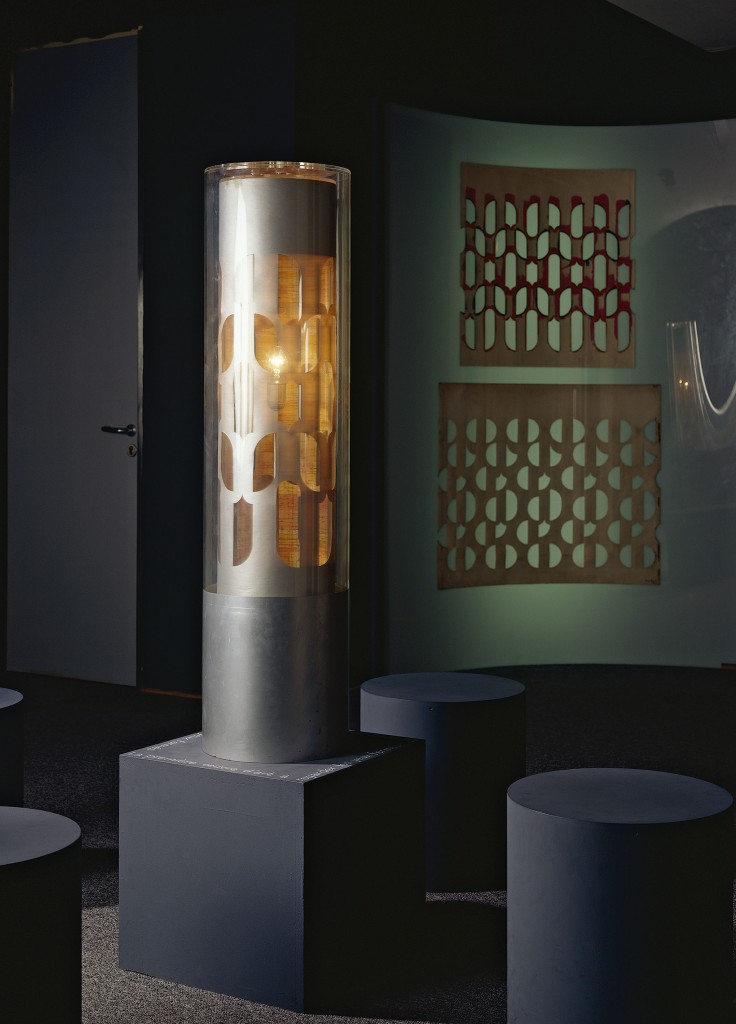
Image:gysin_dreamachine Brion Gysin, Dreamachine, 1961. Perforated metal, electronic motor, lamp, 46 ½ x 11 7/8 in (118 x 30 cm), height and diameter. Musée d’Art Moderne de la Ville de Paris
The Dreamachine: The Mind as the Next Frontier of Painting
In 1961, Gysin and Sommerville developed the Dreamachine. A cylinder with slits cut in the sides with a suspended light bulb at its center is placed on a record turntable and rotated at seventy-eight revolutions per minute; the rotation speed projects light at a constant frequency of eight to thirteen pulses per second, which corresponds to alpha waves present in the human brain during wakeful relaxation. The flickering light on eyelids can create a trance-like hallucinatory state. For Gysin, the Dreamachine brought together the elements of his research. With it, images were freed completely from representation. For Gysin, the future of painting was the mind, which, with the help of the Dreamachine, could be a perpetual, possibly inexhaustible source of artistic revelation. The Dreamachine was officially unveiled in March 1962 at an exhibition titled The Object, at the Museé des Arts Decoratifs in Paris. At the New Museum, an original, functioning Dreamachine will be installed to Gysin’s specifications. Watch Gysin and Genesis Breyer P–Orridge talk about the Dreamachine.
Gysin Collaborates with Musicians
In 1951, Brion Gysin was introduced to Moroccan Joujouka music and became fascinated and extremely influenced by it, leading Burroughs, Brian Jones and the Rolling Stones, and Ornette Coleman to the genre and village from which it came. In the 1970s through the 1980s, Gysin engaged in several collaborations, producing two albums with the jazz experimentalist Steve Lacy and performing live with a band fronted by Parisian punk rocker Ramuntcho Matta. Musicians as varied as David Bowie (who used the Cut-Up Method to write lyrics), Michael Stipe (R.E.M.), Iggy Pop, Patti Smith, Lee Ranaldo (Sonic Youth), Laurie Anderson, Marianne Faithfull, Genesis Breyer P-Orridge (Throbbing Gristle and Psychic TV), and Nick Zinner (Yeah Yeah Yeahs) cite Gysin’s work as an inspiration. Watch Iggy Pop talk about Gysin.
Photo-Collages and Permutations
Gysin continued his experiments merging drawing and writing and produced an artist’s book with hand-written poems entitled Alarme (1974), which will be published for the first time in a limited edition on the occasion of the New Museum exhibition. He also turned to photography, creating compositions of permutated photos that took advantage of the grid formation of the photo contact sheet. Living in Paris across from the Centre Georges Pompidou, then under construction, Gysin’s last works included photo-collages of the Pompidou, as well as The Last Museum, as a novel he wrote in 1985. The final part of the exhibition will include a selection of these collages.
Gysin’s experiments in painting, drawing, performance, installation, and photography have remained on the periphery of the visual-arts discourse. The context in which we can look at the body of Gysin’s work now includes not only art but also the international literary scene; the music world; the social subcultures in New York, Paris, and Tangier; and, of course, the traveling brotherhood of Beat-generation poets, writers, photographers, and musicians. However frustrating it was to Gysin to be ignored by the contemporary art community in his lifetime, it can be argued that being uncategorized has preserved his work, allowing us now to see it as a holistic series of fascinating experiments that expand beyond the typical visual-arts discourse. Forty-five years after his initial discoveries and more than two decades after his death, Gysin’s work has not only endured, but influenced a new generation of artists who are drawn to his radical inderdisciplinarity; interest in the collation, manipulation, and reinterpretation of information; and, perhaps most importantly, his desire to subvert culture with the goal of creating a different way of seeing and of thinking.
www.newmuseum.org/
en.wikipedia.org/wiki/Brion_Gysin

